自古代始,直到清末,烟台市,古称之罘(又写作芝罘),原为登州府(今称蓬莱)辖地,民国元年即1911后始废;登州即今蓬莱市,在烟台西面约四十英里处,今日已成为烟台行政区的辖地。我今写家乡烟台的旧事,所以登州也包括在内。
说来令人啧啧称奇。中国全国第一间大学未设在广州,上海或北京,却设在登州,成立于1876年即清光绪二年。这所学校设在一间久已荒芜的庙堂里,原名“观音堂”,就中学以上设立了文学院,六年后即1882年(光绪八年)才正式宣告成立,定名为“文会馆”,两年后,学生达七十名。1865年,美国传教士狄考文在登州初设此小学,同年,另一位传教士郭显德在烟台也设了小学,两位不约而同,多年后各设四年制的中学。狄考文在登州设大学约四年后,郭显德也在烟台所设的中学以上加设两年制的神道学科和师范科,取正名“会文书院”,成立于1886年。
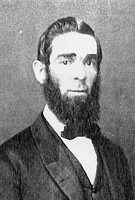
郭显德
Hunter Corbett |
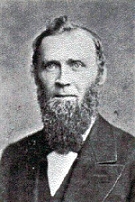
狄考文
Calvin Mateer |
狄考文博士和郭显德博士可说是志同道合;同年出生,既同为美国宾州人,本已婚娶,但皆无子女,又于1863(同治二年)同船自纽约启行前来烟台。他们不但各自兴办教育,且领导救灾工作,例如1876至1877年的旱灾,1889至1890年山东东部的旱灾,中部的水灾,是年兼有蝗虫为患。在工作目标上两人的分别的显明是狄考文专心发展登州的大学,郭显德在山东东部推广小学教育,着重乡区及附近各县。
狄考文在登州广揽人才:举人,廪生,秀才(县学的毕业生,俗称秀才),成为他私人的教师,也在学校担任功课。那时,英汉字典缺少,他迫得藉重英日字典,并聘请了一位日语老师。他在编译科学课本的时候这些日语字眼非常切实而达意。狄考文刻苦用功,不出数年,他便精通了中国语言,全部“三字经”不但朗朗上口,且不出错误。他再经常对学生讲解基督教义的同时也不时说出孔孟之道。他引经据典的古书是大学,中庸,论语和孟子,统称四书。
专心致志
狄考文的努力目标是在培养具最高道德观的优良师资和专心传扬基督教义的人才。他认为中国民间普遍存在的迷信风气是社会进步与发展的最大的障碍,唯有将基督教传开才能挽救。他相信科学足以改善生活和生存的环境,然后迷信可解,民生水准必然得以提高。他不主张学生必读英语,除非在学术上有此需要。学生卒业后既在本国服务,因此英语不必列为必修课。基于此,他开始编写中文教科书。
1895年即光绪二十一年,他从事教书和写课本工作已进入第三十四年,他写的教科书已达28本,并已出版,其中八成是科学范围的。另外有七本出版的书由他人出名,却是经狄考文授意并指导才完成的。上海至少两间著名的印刷出版商抄袭了他的著作,成为己出,因为那时还没有“版权所有翻印必究”法规。狄考文除了教书和写作,出版工作以外,他关心学生合作精神的启发,组成学生青年会,以德,智,体三育为宗,学术探讨与辩论会及其他会社,用以联络感情。他为学生设医务室。他亲自施局部麻醉,给学生拔除病牙,伤口敷药,折骨上石膏和绷带包扎等工作。
他禁止学生吸烟饮酒,不拘在校内或校外,更进一步对学生在校外的非法活动也加调查。经常他以严肃的态度对待学生,在那个时代,一位校长必须维持应有的尊严。结果学生对狄考文既敬爱又惧怕,给他起一绰号“狄老虎”。每届喧闹的场面,祇要经一人喊出“老虎”,顿时全场鸦雀无声,由此可见狄考文的威仪如何了。先严,慈皆先后负笈登州,家住烟台时期常有同学来访,谈及当年学校趣事,必津津乐道。
1879年即光绪五年,他应邀返国去参加美国全国长老会的年会。会毕,他迳去费城负有盛名的包德温火车头制造厂(该厂创于1854年)去当学工,历数月,俾将所学在登州教导学生并付实用。1893年,他前去芝加哥参观美国全国的工业展览,以便选购他在登州的工作兼研究室所需的设备。期前,他已购得化验室应有的化学试药,锅炉带蒸气机,发电机,柴油机,电镀设备,制螺丝钉机,气焊设备,瓦,木,铁匠应用的工具等。他走在时代的前面,那些设备就中国全国的校园来说应属首屈一指。参加此次的工业展览,他又添购了一些物理和生物课室应有的设备和器材。狄考文将他的工作兼化验室每年一次做公开展览,届时必在会场上做讲述。初度的展览会留有纪录:应邀的宾客和参观的人数是一万二千。
结谊驻军
登州区清军的最高长官是宋庆将军,在他的麾下有一名军头,名叫袁世凯,此人和狄考文交好。清军没有修械所,因此军器的维修工作有赖于狄考文的相助。某次,清军一士兵去寻花问柳,污辱了女校的学生,那时男生基于义愤,在街市上见了清军就打,闹得满城风雨,双方不可开交,结果狄考文和袁世凯两人出来当了和事佬,卒化干戈为玉帛。
十年的时光易过。袁世凯官运亨通,步步青云。甲午战争(中,日为朝鲜而战,陆,海两方面中国大败,事在光绪二十年即1894)时期,袁世凯已荣膺清廷驻朝鲜的总办。
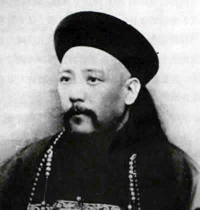
义和团之乱时救助西方传教士的
山东
巡抚袁世凯
Governor Yuan Shih-Kai |
1900年义和团之乱时期,袁世凯任职山东省巡抚。那时在山东内地工作的西方传教士与家属安全难保,狄考文电致袁世凯求助,袁便应其所请,特派武装兵士予以护卫,自起程地到寿光县的海口羊角沟,时由烟台方面自己雇轮船来接。被救助的西人约七十馀,此全体照我曾见过。袁世凯又电请北洋水师统领萨镇冰亲率其座舰“海坼”前赴登州海岸将该地的传教士与家人接送到朝鲜。今日北韩之都的平壤是当年美国长老会教区的中心。次年九月,中日合约成立,全部才返回登州。当时自登州撤退的西侨中有一个两岁的男孩,那是后来举世闻名的鲁斯。他手创时代周刊,后来又创生活和幸运,此三种周报和月刊是二次大战前在美国以至世界最风行的杂志。鲁斯生于登州(九岁时在烟台读书,十四岁才离开中国前往英国,后卒业耶鲁),他的双亲都是男校,女校的教员。父亲Henry
Winters
Luce被译作路思义,正职牧师。此公最有募捐与说服的本领,给后来于1904年在潍县建校(广文大学)和1917年在济南建校(齐鲁大学)先后在美国募捐了约三十万美元,当年乃是偌大的数字。
在袁世凯的任内,山东全省在义和团之乱的时期无一西人伤亡。此情此德完全归功于狄考文和袁世凯两人之间存在的友谊。山东方面的安谧激怒了慈禧太后,气得咬牙切齿,正欲召袁世凯前来北京治罪,却不意八国联军忽临城下,捣毁了宫殿与颐和园。慈禧离京逃难西去后予袁世凯治罪之议便悄然而废。民国成立,袁世凯出任第一届正式大总统。
功果互见
1890(光绪十六年)在中国的基督教会成立一个翻译圣经的委员会,因为当时没有一个统一性的中文圣经,它是由华北,华南,华东各地的学者组成的,但工作推行迟滞,协调的意见和译法不易达成。八年后,狄考文被选为主席,此后工作加速,每年在烟台或登州举行会议一次,虽然每次辩论的气氛总是紧张。又过了十年即1908年,在狄考文因逝世而卸任的时候,“新约全书”已经完成。“诗篇”的译本也近完成中。“新旧约全书”的完成和正式版又过了十多年才得实现。那就是今日习称的“和合本”,被国内外中国基督徒所认为最标准的译本。
在狄考文创立文会馆担任馆长期间,他曾为本地商人设计了磨麦粉机,打谷去壳机,煤球机,麻绳机,织麻袋机。他认为改善民生和宣传基督教义必须相辅而行,民生提高必会造成宗教深入民间的机会。在1882年还未宣布成立大学之先,已经有十一名学生通过了同等学历的大学考试。在大学成立后直到狄考文于1895年请辞,八年之间,大学卒业考试合格的共有68名,加上前期的11名,共为78名,其照片及简历全部载于“文会馆志”。
狄考文于1895年辞职办教育的史实是在说明他从事小,中,大学的教育工作完成了三十年,包括十一年致力于大学。他决定将生命的馀年从事化验工作室,写作,翻译,演讲,出版教科书,证道,旅行等。他研读中国文字和古书已届二十五年,就其所得写书一本,可译作“国语速成”读者须价购。此书一度洛阳纸贵,风行一时,狄考文将利润赞助在校的苦学生,和支付他化验工作室的额外开支。
承先启后
狄考文的后继人是赫士,在他负责文会馆(当时称馆长)的第六年,应山东巡抚袁世凯的请求前去济南设立“山东高等学堂”,那是山东大学的前身。1901年,也就是义和团之乱以后八国联军入北京的第二年(光绪二十八年),有五位文会馆的优秀毕业生随行。赫士创校的同时,他举办成功山东全省的第一间日报。他上书清廷请全国参照世界的习惯宣布星期日休假,清廷采纳了他的意见,通令全国一体遵行,并致书赫士表示嘉奖。
1901年柏尔根接替赫士的工作。三年后,应时势的需要,文会馆的大学部迁往潍县。此时(1904),德国修筑的胶济铁路完成,潍县(今潍坊,系潍县和原坊子合称)接近山东和铁路的中部,是为交通要冲。同时文会馆决意和原在青州(今益都)英国浸礼会所创办的广德书院合并,各取一字,命名广文大学,包括三个学院:文科(又称文理科),神道学和医科,此时全体学生总数是120名。迁校的第二年,狄考文才将他的化验工作室迁来潍县,原因是交通不便,运输大半借重骡马的驮负。狄考文在室前加筑了一座美国式风车汲井水的设施,成为当时的一特景,也是潍县东南区的标志。广文大学的校园那地址取名“乐道院”。
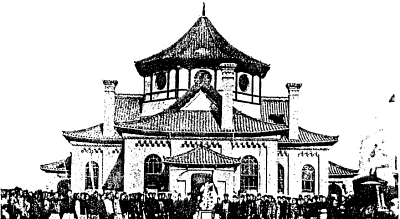
1904年迁校潍县广文大学的礼堂
狄考文七十寿辰满清官员来贺
Weihsien Church on the occasion of the Seventyeth
birthday of Calvin Mateer, when he was greeted
by Manchu officials of Shandong government.
1903年,在文会馆迁校的前一年,狄考文应邀出席参加假洛杉矶市美国长老会的全国会议,他拒绝了主席名衔及任务,因为他在1863年离开纽约以前已经公开许下愿望:“我终生将为中国人工作,死于斯,葬于斯!”他认为在以后的数年里从事翻译圣经,并担任委员会的主席的任务比在美国担任长老会的主席更重要。1906年,当“新约全书”完成时,他已经召集译经委员会八次,每次历时两至六个月,假北京,登州和烟台三地举行。
1908年,那次委员会在烟台召开,狄考文罹病,可能为阿米巴性痢疾。此病在当时无药可治,被称绝症。他前往青岛德国医院就医,不幸遽逝,享年七十三岁。遗体海运烟台等候礼毕下葬。先严是狄考文的学生,于1908年卒业于潍县广文大学,时正供职保定陆军师范,闻讯赶赴烟台主持中国人予他的纪念仪式。下葬前的团体照片的注脚为先严用毛笔写出“西历一千玖百零八年十月四号狄大牧师葬于烟台玉皇顶图”,共二十六个字。从照片上我认得出,先严的上半身正对着行将下葬的棺木。
山东大学
柏尔根于1915年病殁下葬潍县。两年后,校迁济南,南京,北京,渖阳,汉口四间医专全部迁此合并成立齐鲁大学,因此增加了十个以上西方差会的支持。五十年代,齐鲁被迫关闭,校址今为山东大学的所在。
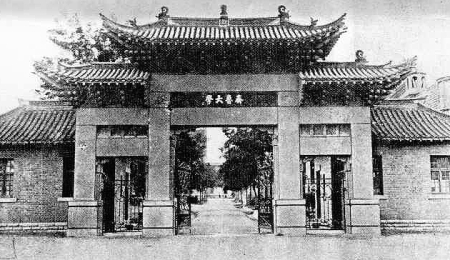
先文会馆,次为广文,至终成立齐鲁大学-今山东大学校址
Built in 1917, the Gate of Chee-Loo University, Jinan ---
a successor to the college in Weihsien.
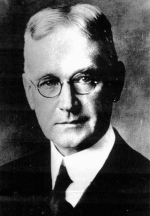
路思义牧师
Henry Winters Luce,
father of Henry Luce,
head of Time-Life +
Fortune. |
齐鲁大学校园里有两座科学大楼,一为狄考文纪念馆,另一是柏尔根纪念馆。饮水思源,广文和齐鲁两校舍建筑经费的募集,路思义厥功甚伟。后来路思义北上北京,助史徒雷登建设燕京大学,在美国又募得钜款。校园里有鲁斯纪念馆即为明证。父子的中译法不同:父亲是路思义,儿子被译作鲁斯,那纪念馆是儿子的赠物。鲁斯生于蓬莱,前面已有所述,他是时代周刊和生活,幸运共三种杂志的创办人兼主管。路思义在华工作的晚期患胃溃疡,提前退休返国。他逝于日本偷袭珍珠港(1941年12月7日)同日的晚上,显然因为受了震惊。那夜,座上客林语堂为其中之一。儿媳鲁斯夫人是美国有史以来的首任女性国会议员,首任女性驻外大使。他自1953年膺任驻意大使,1957年卸任返国。
二次大战日本与中国的盟国交战时期(1941-1945)潍县原广文大学即“乐道院”,被改做俘虏营,日本军方将在全华北的盟邦侨民老少约1500人集中管理于此直到胜利以后于1945年八月十七日才被释放了。关于盟邦侨民被拘的始末和营中情况的记载很多,其中最有名的两本书其一为纽泽西州女议员戴爱美所写(A Song of
Salvation at Weihsien Prison
Camp),另一的著者是英国的柯喜乐,他写书十本以上。两位都是中国出生。
前面曾提到赫士。他继狄考文任文会馆的馆长六年,为袁世凯设山东高等学堂,后来创设华北神学院于山东滕县。赫士和夫人被拘于潍县集中营,不介意于国际红十字会主持下的美日两国俘虏的交换机会,拒绝返国,俾于战后继续在中国工作,但不幸于胜利前一年逝于潍县,幸有他的儿子在侧,年迈的赫士夫人得有照顾。
值得怀念
1980年代,我多次向费城的长老会史学会索取数据俾可写一篇纪念狄考文生平的中国文章。我见宾州首府哈城有许多狄考文同姓的人,便试以电话相询,却不料没有一户人家知道1863年来华兴学传教编写教科书那位名叫狄考文的其人其事。原来哈城就是狄考文生长的地方。狄夫人一生未育,自始至终在女校工作,比狄考文早逝约十年,双双俱下葬烟台毓璜(玉皇)顶的北麓。此坟地距我家不足一英里。虽他在我出生七年前已逝世,但他生平的事迹,形像,对学生和一般中国人的关心爱护,经过长辈们的述说总是常驻我心。在我家客房里墙上所悬挂的纪念相片,狄考文的半身照就在其中。
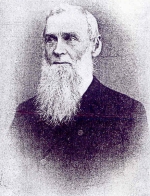
狄考文晚年最后一张照片
Calvin Mateer. |
那时代,各地需求合格的师资甚殷,狄考文的学生最合需要,毕业生应聘各大专校:京师大学堂即北大的前身(自开学算起,两年后八国联军的德,俄两国强占为驻军养马之地),上海圣约翰大学,保定陆军学堂,云南讲武堂(军专)及其他著名专校与中学。我曾在烟台读益文商专的中学,当时数,理,化,生物等科的老师各皆毕业于登州文会馆或潍县广文大学。
狄考文毕生工作于中国满了四十年。根据他的自述,估计在中国旅行一万二千英里,对学生讲话除外,演说与证道8,000次。狄考文未写自传。他一生尊孔子为大师和圣人。他步伐与孔子同,“其为人也,发愤忘食,乐以忘忧,不知老之将至”,享年也同是73岁。
最近,狄考文的老同工郭显德的墓碑已被发现,因此我函烟台史志办公室的刘铭伟主任请求在原美国墓地带代为查找。他覆信说明,那原墓地早经铲平,居其上的是成行的高楼大厦。郭显德的墓碑是在此山上警备区院里被发现的。当日何人为何将郭公的墓碑私藏彼处而保存至今?此谜已不可解答。狄公之墓碑既不可寻,故特写此文以志纪念。
The First College In
China
Moses
Chu
The Beginning
Since ancient times
until the end of the Qing Dynasty, Chefoo (now Yantai)
was within the prefecture of Tengchow, a name that
ceased to exist once China became a Republic in 1911.
Presently, Tengchow (now Penglai, located 40 miles west
of the city of Yantai) is within the district government
of Yantai. As I write about my hometown, Chefoo,
Tengchow is naturally included.
It is amazing that
the first college in China was established in Tengchow
in 1876, and not in Canton, Shanghai and Peking. It was
built on the ruins of the “Temple of Goddess of Mercy.”
But the name, Tengchow College of Liberal Arts, was not
formally given and declared publicly until 1882, the
second year in the reign of Emperor Kuang Hsu. In two
years, the college enrollment reached 70. Schools of the
early 1860s in Tengchow, like the Hunter Corbett School
in Chefoo, were only 6-year primary and 4-year middle
schools. When Calvin Mateer, the founder and principal
of the boy's school, formerly established a college in
Tengchow, Hunter Corbett added new classes in theology
and teacher training at his school in Chefoo. The Chefoo
School was then renamed as the “Hunter Corbett Academy”
in 1886.
Hunter Corbett and Calvin Mateer had many
things in common; both were born in Pennsylvania in the
same year, received D.D. degrees, married but without
children and came to China in 1863 by the same boat.
There had been a very close relationship and cooperation
between them. Along with other colleagues, they worked
together in disaster areas of Shantung province during
the famine of 1876-1877 and in other areas struck by
flooding, drought, and the plague of locusts in
1889-1890. But unlike Hunter Corbett in opening
pre-college schools all over the eastern Shantung,
Calvin Mateer did not expand his activities of opening a
college elsewhere other that in Tengchow and its
adjacent areas.
Mateer hired accomplished scholars
― Xiu Cai, Lin Sheng, and Ju Ren as his tutors and
school-teachers. At the time, since an English-Chinese
dictionary was not available, he had to manage the class
using a Japanese-English dictionary and engaged a
Chinese language tutor to help in his work. This was
particularly essential when he wrote science textbooks.
In a few years, his hard work enabled him to gain
mastery over the Chinese language. He studied many
Chinese classics; he was able to recite the San Zi Jing,
or three-characters classics, without mistakes. In his
speeches and sermons he often quoted the teaching of
both Confucius and Mencius from “The Four-Books:” the
Great Learning, the Doctrine of the Mean, the Analects,
and the Book of Mencius.
Dedication
Mateer's aim was to
create the best teachers of the highest academics and
moral standards, and to train pastors to spread
Christianity in China. His opinion was that since social
superstitions had held the China back from keeping up
with the developing world, this situation could be
improved only by spreading the doctrine of Christianity.
He also believed that only the science could make the
people and the country productive by improving the
living conditions and intellectual standards. He
insisted that English should not be taught to Chinese,
unless it was absolutely necessary, because the
graduates should teach and serve the common people in
China. In order to achieve his goal, he started to write
textbooks in Chinese.
1895 marks Mateer's 34th
year of writing and teaching. He set a record of
finishing 28 books, duly published, for middle school
and college students. 80% of the 28 were books on
science. Seven other books were written or compiled by
his colleagues and students under his initiative and
guidance. Prominent text book publishers in Shanghai
found these books a great resource of literature and
enjoyed the fact that these materials could be copied
free of copyright issues. In addition, He organized news
clubs, a YMCA, a debating society, etc. in the school.
He opened a small pharmacy for the students. He
administered local anesthetics for tooth extraction,
dressed wounds and applied plaster casts.
Mateer
forbade the use of tobacco and alcohol either inside or
outside the campus. Often he made inquires into the
conduct of his students. Usually he was stern and
serious in manner, a splendid image in those days of a
school principal. So much respect, love and fear were
interwoven the minds of his students, thereby earning
him a nickname of “Di Lao Hu.” His name in Chinese was
Di Kao Wen, with Di as his surname. His nickname meant
“Di, the Tiger.” At any noisy gathering of students, one
only had to utter the words “Lao Hu” for a prompt hush
to follow. Both my parents were educated in Tengchow and
many interesting stories were told of him whenever their
former schoolmates or friends came to visit.
In
1879, Calvin Mateer went back to the United States to
attend a general meeting of the Presbyterian Church.
After the meeting, he entered the renowned Baldwin
Locomotive Works (established in 1854) in Philadelphia
as a trainee for several months, so that his experience
could be used in Tengchow. In 1893, he attended The
Industrial Exhibition held in Chicago to buy instruments
and equipment for his workshop and laboratory at
Tengchow College. Previously, he brought to Tengchow
testing chemicals, a boiler with a Watt engine, a
dynamo, a diesel engine, electroplating equipment, screw
machine, gas-welding and tools needed for masonry,
blacksmithing, and carpentry. In those days the brand
new setup was probably a prototype and the first of its
kind in China. He brought enough instruments for his
physics and biology classes. Once a year there would be
a day for showing his workshop to the public; some
12,000 visitors saw his first exhibition, and he was
always there to answer questions.
Relations with Chinese
Military
Mateer often helped the
local military in doing repair work. A friendship
developed between he and Yuan Shih-Kai, and officer
under General Sung Ching, the regional military
commander. Once a soldier behaved badly to a female
student and some of the male students came to her
rescue. This triggered a fight between soldiers and
students, and became a very serious incident. Finally an
amicable settlement was reached through the meditation
of Calvin Mateer and Yuan Shih-Kai.
More than 10
years passed. During this period, Yuan Shih-Kai earned
many promotions. He was the viceroy in Korea during the
Sino-Japanese War in 1894 and then the governor of
Shangtung province. During the time of the Boxer
Rebellion (1900) when the missionaries and their
families were in grave danger, Calvin Mateer wired
Governor Yuan Shih-Kai for help. Yuan sent soldiers to
escort the evacuees who were traveling from interior
cities to Yang-jue-Gou aboard a steamer for Chefoo. I
have seen this picture showing over 70 people, including
children. Yuan Shih-Kai also asked Admiral Sa to
dispatch the flagship Hai-Chi to Tengchow in order to
accommodate evacuees going to Korea. On arrival in
Korea, they took temporary lodging in the Presbyterian
Center in Pyongyang, (now the capital of North Korea)
until the peace treaty was signed in September of the
following year. Among the evacuees from Tengchow was the
two-year-old Henry Robinson Luce, who later became the
founder of Time, Life, and Fortune, the most popular
magazines in the United States before WWII. This child
was born in Tengchow, and his father Henry Winters Luce
was also a Presbyterian missionary and a teacher at
Tengchow College. By virtue of his influence and efforts
in the United States, he later raised a large sum of
money for the college.
Under Governor Yuan
Shih-Kai, no foreigners were harmed during the Boxer
Rebellion throughout the Shangtung province. The
friendship that existed between him and Calvin Mateer
was the primary factor. This particular development in
Shangtung angered the Empress Dowager Tsu-Hsi who wanted
the governor to be summoned to the capital (Beijing) for
punishment. However, before this could happen the joint
force of the eight foreign powers had already invaded
and occupied the capital, ransacking the palace and the
summer palace of Yi-he Yuan. The Empress Dowager had to
flee the capital. Later, the case against Yuan Shih-Kai
was quietly dropped. When China became a republic in
1911, Yuan Shih-Kai was chosen to be the first
president.
Community Service
In 1890, a committee
for translating the Bible was formed by scholars from
the eastern, central, and northern provinces of China.
Little progress was made until Calvin was elected as the
committee chairman in 1898. The committee convened once
a year, mostly in Tengchow and Chefoo with diverse
opinions expressed in a tense atmosphere. The
translation work moved very slowly. At the death of
Calvin Mateer in 1908, only the New Testament was
completed and the Book of Psalms barely completed. It
took more than ten years for the translation of the
first Chinese Bible to be completed and published for
the first time. It was called the “He-He-Ben” or The
Union Version, a standard translation that is considered
the best version and is still used throughout the world
by Chinese speaking Christian churches.
When
Calvin Mateer was the principal of the Tengchow College,
he designed gratuitously for the local businessmen a
grain grinder, husking machine, coal-ball making
machine, hemp twisting and weaving machines for making
bags. His conviction was that improvement of the
livelihoods for the common people should go side by side
with the spread of the Gospel and that the former would
automatically promote the latter. Prior to establishing
the school's formal status as a college in 1882, 11
students had already successfully passed the college
examination. During Calvin Mateer's tenure at Tengchow
College, 68 students graduated between 1887-1895 (the
year of Mateer's resignation). This makes a total of 79
graduates. Their names and individual photographs
appeared in “The Chronicles of the Tengchow
College.”
Due to the heavy burden at school,
Calvin Mateer decided in 1895 to resign and transfer his
duties to his assistant, Watson M. Hayes, D.D. After the
completion of educational works for 30 years including
11 years as the principal of the College, he wanted to
have enough time to work in his laboratory and workshop
and to write, teach, translate, publish, preach, travel,
etc. Through his experience of 25 years in language
studies he wrote a book entitled “Mandarin Lessons”
which was sold and read widely. He used the profits for
helping poor students and for new purchases for his
workshop.
Transition Years
Mateer's successor,
Watson M. Hayes, left Tengchow College to establish a
provincial college in Tsinan (Jinan, the provincial
capital) in 1901 at the invitation of Yuan Shih-Kai, the
governor of the Shantung province. He brought with him
five former graduates of Tengchow College to assist him,
working as teachers. He successfully established the
college in Tsinan, and also founded the first daily
newspaper in the province. He made a proposal to the
Manchu Royal Court that, following the international
custom, Sunday ought to be declared a day of rest
throughout the country. This was finally adopted with a
letter issued to him expressing appreciation.
Watson M. Hayes was succeeded by Paul D. Bergen, D.D. as
the principal of the Tengchow College in 1901. After
three years, he supervised and undertook the task of
moving the college to Weihsien (now Weifang) in 1904.
Weihsien was halfway by rail between Tsingtao (Qingdao)
and Tsinan. Simultaneously, the Tengchow College merged
with a college founded by British Baptists in Tsingchow
(now Yidu). Taking one Chinese character from each
former school created a new name, “Guang Wen,” The new
school became a university with arts, theological and
medical colleges with 120 students. It took one more
year for the laboratory and workshop to be moved and set
up in the new college campus, due to the limited
transport using only mules. Calvin Mateer erected a
windmill near his workshop, a landmark visible for few
miles southeast of the city of Weihsien. The campus was
named “Le Dao Yuan” or “The Courtyard of the Happy
Way.”
In 1903, one year before the college moved
to Weihsien, Calvin Mateer attended an annual general
meeting of the Presbyterian Church held in Los Angeles.
He publicly declined to be nominated as the Chairman. He
stood by the vow he made in New York before his
departure in 1863, “I shall work among the Chinese
people, die, and be buried there.” His service as the
Chairman of the Bible Translation Committee was an
important contribution in the coming years. By the time
the translation of the New Testament into Chinese was
completed in Chefoo during the summer of 1906, the
committee had met over eight times for 2-6 months each
time in Peking (Beijing), Tengchow, or Chefoo.
In
1908, the committee meeting was held again in Chefoo
when Mateer was ill, presumably from amoebic dysentery,
a deadly disease in the absence of a proper cure in
those days. He went to Tsingtao and entered a German
hospital for treatment but died there at age of 73. His
casket was brought to Chefoo for burial. My father, a
graduate in 1908 of the college, and then a teacher of
science in the Paoting Military Officers' Training
College, rushed back to Chefoo to attend the memorial
and burial ceremonies. In a particular picture I was
able to identify him in the front among a group of
mourners. His writing using a brush pen on the bottom of
the picture reads, “On October 4th, 1908, the Burial of
the Most Reverend Dr. Calvin Mateer took place at Temple
Hill Cemetery, Yantai.”
Shandong University
In 1915, Paul Bergen,
the principal of the Guan Wen University, died after a
short illness and was buried in Weihsien. In 1917, the
college moved to Tsinan and merged with medical colleges
from Hankow, Nanking, Peking, and Mukden, giving a new
name “Cheeloo University” with additional support from
over ten foreign missions. The site is now being used by
Shandong University.
On the campus of Cheeloo
University, two memorial buildings were built named
after Mateer and Bergen respectively. Henry Winters Luce
traveled to the United States several times with much
success to raise large sums of money for the
construction of the new campus in Tsinan. He later went
to Peking to help Leighton Stuart, the principal of the
Yencheng University, again to raise money in order to
add new buildings including the Luce Hall donated by his
son, Henry R. Luce, the managing director of Time, Life,
and Fortune magazines. The senior Luce had to retire
early, having suffered peptic ulcers for many years. He
died the night of the Pearl Harbor incident on December
7, 1941, in his son's home in Greenwich, Connecticut,
obviously due to shock and grief. That night, Lin
Yu-Tong was among the guests of the Luce family. His
daughter-in-law, Clair Boothe Luce, was the first
congress-woman and lady ambassador in U.S. history. She
held the post of ambassador to Italy from 1953 to
1957.
During WWII (1941-1945) after the Pearl
Harbor attack by Japan, the old Le-Dao-Yuan campus was
turned into an internees' camp by the Japaness military.
Nationals of all allied countries from north China were
imprisoned there until its liberation on August 17,
1945. There were about 1,500 internees. Many books were
written about the life in the camp, by famous writers
such as Mary T. Previte of New Jersey, now an assembly
woman in the state council and Dr. Norman Cliff of
England, a retired church minister and the author of
more than ten books. Both of them were born in
China.
Watson M. Hayes was the founder and
principal of the North China Theological Seminary
established in Tenghsien. He and his wife were interned
by the Japanese military in the Weihsien Internee's
Camp. For many reasons he refused to de repatriated
under the “Prisoners Exchange Project” organized by the
International Red Cross. Aside from Mrs. Hayes, his son
accompanied him in the camp. He died in 1944, just one
year before the liberation.
Remembrance
When I lived in
Lancaster, Pennsylvania in the 1980's, I obtained enough
materials with the help of the Presbyterian Historical
Society in Philadelphia for writing Dr. Mateer's life
story in Chinese. I made telephone calls to more than
ten Mateer families in his hometown, Harrisburg, but
none had any knowledge of this beloved and respected
Calvin Mateer. He had no children and his wife of the
first marriage who was teaching in the girl's school,
died ten years earlier than Calvin Mateer. They both
were buried in the cemetery on the north slope of the
Temple Hill in Chefoo. This cemetery was less than one
mile from my parents' house where I grew up. Even though
his death occurred seven years before I was born, his
image, work, and love for his students and the Chinese
people is forever in my heart. In the sitting room of my
parents' house in Chefoo, his photograph was one among
many hanging on the wall.
Demand for competent
teachers was high in those days. Calvin Mateer's best
students were eagerly invited to teach in the Capital
University (1898-1900), the predecessors of the Beijing
University, St. John's University, Paoting Military
Academy, Yunan Military School, and many prominent
middle schools. When I attended the middle school of the
Yih-Wen Commercial College, practically all the teachers
of science, mathematics, physics, chemistry, and biology
were his students, or graduates of the College in
Weihsien.
Calvin Mateer toiled in China for over
40 years. According to his own estimate, he traveled
12,000 miles and gave 8,000 speeches and sermons besides
class lectures. But he did not write his own biography.
Calvin Mateer admired the teachings of Confucius and
often hailed him as a great teacher and saint. He
followed the steps of Confucius: “A person who forgets
to eat when he is buried in his work, who forgets all
his worries when he is happy, and who is not aware at
all that his old age is coming on!” They both lived to
the same age-73.
The recent discovery of the
tombstone of Hunter Corbett, his colleague, prompted me
to write to Mr. Liu Ming-Wei, the director of Yantai
Local Chronicles office, requesting information on other
tombstones in the cemetery. His explanation was that the
former tomb area was leveled a long time ago and
presently standing on the site are rows of tall
buildings. In fact, none other than the Corbett's
tombstone was found in the city garrison area. How and
why only this particular one was preserved and protected
is a mystery. When a memento like a tomb or tombstone is
lost, all that can be done now is to have the story
briefly retold.
|